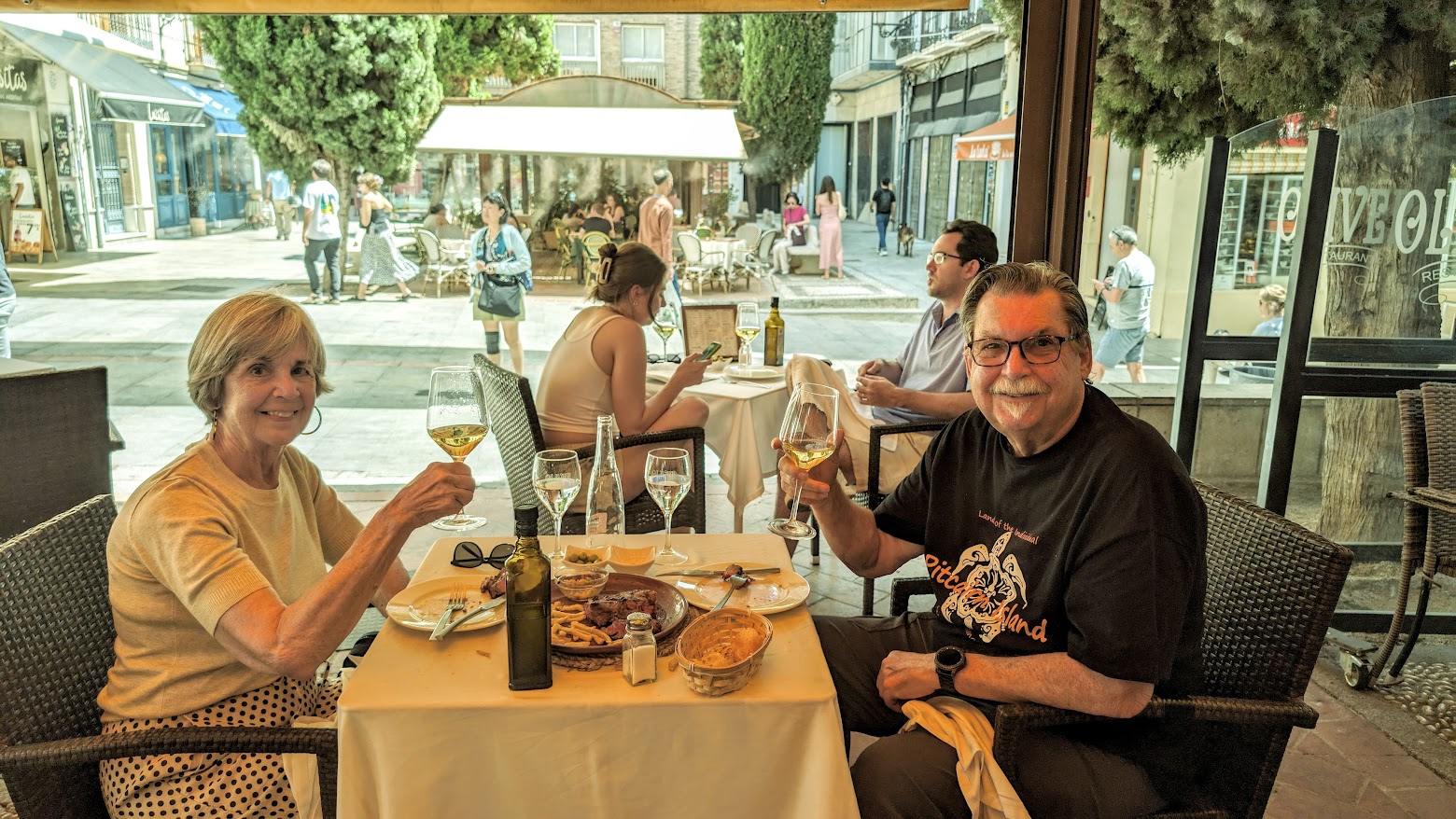“𝑨𝒉, 𝒕𝒉𝒆 𝒔𝒕𝒐𝒓𝒚𝒃𝒐𝒐𝒌 𝒌𝒊𝒏𝒈𝒅𝒐𝒎 𝒐𝒇 𝑮𝒓𝒂𝒏𝒂𝒅𝒂. 𝑶𝒏𝒆 𝒐𝒇 𝒕𝒉𝒆 𝒐𝒍𝒅𝒆𝒔𝒕, 𝒎𝒐𝒔𝒕 𝒄𝒐𝒎𝒑𝒍𝒆𝒙, 𝒎𝒂𝒈𝒊𝒄𝒂𝒍𝒍𝒚 𝒔𝒖𝒓𝒓𝒆𝒂𝒍 𝒑𝒍𝒂𝒄𝒆𝒔 𝒊𝒏 𝑺𝒑𝒂𝒊𝒏. 𝑨𝒏𝒅 𝒐𝒏𝒆 𝒐𝒇 𝒕𝒉𝒆 𝒎𝒐𝒔𝒕 𝒃𝒆𝒂𝒖𝒕𝒊𝒇𝒖𝒍.” ~𝑨𝒏𝒕𝒉𝒐𝒏𝒚 𝑩𝒐𝒖𝒓𝒅𝒂𝒊𝒏
Saint Anthony Bourdain inspired our whirlwind of eating and drinking in Granada last week. We were determined to walk in his footsteps. The late great chef provocateur filmed an episode of “Parts Unknown” in 2013 featuring five tapas bars here. We planned to check out the same ones. But not all in one night, as Boudain and pals did. And not eating exactly everything he did. We’re no match for his try-anything appetite, stamina, or even his biting, irreverent prose. Who is?
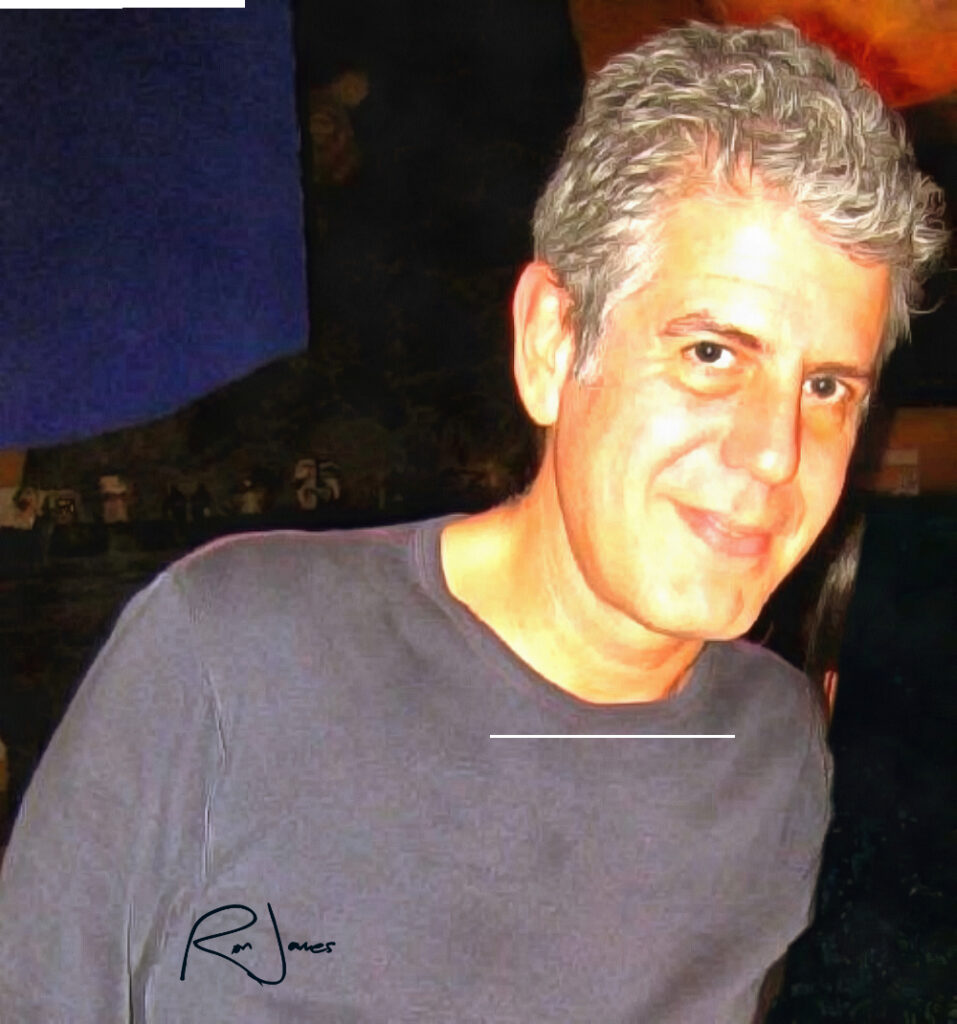
This week marked the 6th anniversary of his tragic suicide. He was found in his hotel room in France, where he was working on an episode of “Parts Unknown.” He was 67 years old.–and he had it made – a culinary rockstar who transformed the concept of travel and food tourism. Several food and travel series since have tried to emulate his style, but none has even come close. He is still an inspiration to us, and millions of other fellow travelers and food lovers around the world.
Years ago, when he was on the cusp of fame, I interviewed him for my nationally syndicated wine and food column, “Perfect Pairings.” Bourdain, a rather obscure chef working in the hot kitchens of New York City, gave the world a glimpse of his razor wit and searing honesty in “Kitchen Confidential” (2000). This professional memoir served up an unfiltered look at the sometimes grim reality of working in New York’s high-end, high-pressure kitchens.
As the book climbed the bestseller charts, I was offered a phone interview with Bourdain. “Mr Bourdain is very busy,” the publicist explained. “The interview would be 15 minutes, no longer.” Now by this time, Tony Bourdain already had a reputation for not suffering fools gladly– especially if the fools were journalists with stupid questions.
I had interviewed several superstar chefs by then, but I was intimidated, and more than a bit nervous. No stupid questions, I vowed. In the end, it was a wonderful interview. Bourdain was charming and chatty. Our 15 minutes extended to 60. I hung up with new respect for the man and a good deal of professional self-satisfaction.
𝐁𝐨𝐮𝐫𝐝𝐚𝐢𝐧 𝐢𝐧 𝐆𝐫𝐚𝐧𝐚𝐝𝐚 𝐒𝐩𝐚𝐢𝐧
Granada is most famous for three things: The Alhambra, the last stronghold and architectural marvel of the Moors who ruled here for nearly 700 years. The resting place of King Ferdinand and Queen Isabella, who funded Columbus’ world-changing voyages. And the tradition of serving free tapas when you order a drink. “This is still one of the few places in Spain where they’re free. All you have to do is keep drinking,” Bourdain explained in his program on Granada.
Bourdain visited Andalucia during the pageantry-filled Semana Santa or Holy Week, the week before Easter. His tour guide was his longtime friend, cinematographer Zach Zamboni, who lives part time in Granada and had been imploring Bourdain to visit for years.
In addition to dining out, Bourdain wandered the streets of some popular neighborhoods, visited the Alhambra, and took in a Flamenco show in the Moorish Albaicin neighborhood. For him, learning about history and culture is the heart of his travel philosophy. Food and drink, he believed and so vividly showed, are windows into the soul of a place. It’s a viewpoint we share, one that always colors our travel adventures.
In the Granada show, Bourdain reflected on Spain.
“𝑺𝒑𝒂𝒊𝒏 𝒊𝒔 𝒕𝒉𝒆 𝒔𝒐𝒓𝒕 𝒐𝒇 𝒑𝒍𝒂𝒄𝒆 𝒕𝒉𝒂𝒕 𝒏𝒆𝒗𝒆𝒓 𝒓𝒆𝒂𝒍𝒍𝒚 𝒎𝒂𝒅𝒆 𝒂𝒏𝒚 𝒔𝒆𝒏𝒔𝒆 𝒂𝒏𝒚𝒘𝒂𝒚. 𝑩𝒖𝒕 𝒊𝒏 𝒕𝒉𝒆 𝒗𝒆𝒓𝒚 𝒃𝒆𝒔𝒕 𝒑𝒐𝒔𝒔𝒊𝒃𝒍𝒆 𝒘𝒂𝒚. 𝑻𝒉𝒊𝒔 𝒊𝒔 𝒕𝒉𝒆 𝒄𝒐𝒖𝒏𝒕𝒓𝒚 𝒕𝒉𝒂𝒕 𝒈𝒂𝒗𝒆 𝒖𝒔 𝒕𝒉𝒆 𝑺𝒑𝒂𝒏𝒊𝒔𝒉 𝑰𝒏𝒒𝒖𝒊𝒔𝒊𝒕𝒊𝒐𝒏. 𝑨𝒍𝒔𝒐 𝒂𝒏𝒂𝒓𝒄𝒉𝒚. 𝑻𝒉𝒊𝒔 𝒊𝒔 𝒘𝒉𝒆𝒓𝒆 𝒅𝒆𝒗𝒐𝒖𝒕 𝑪𝒂𝒕𝒉𝒐𝒍𝒊𝒄𝒊𝒔𝒎 𝒎𝒊𝒙𝒆𝒔 𝒘𝒊𝒕𝒉 𝒔𝒖𝒓𝒓𝒆𝒂𝒍𝒊𝒔𝒎, 𝒎𝒐𝒅𝒆𝒓𝒏𝒊𝒔𝒕 𝒄𝒖𝒊𝒔𝒊𝒏𝒆 𝒘𝒊𝒕𝒉 𝒕𝒓𝒂𝒅𝒊𝒕𝒊𝒐𝒏𝒂𝒍 𝒕𝒂𝒑𝒂𝒔. 𝑪𝒉𝒓𝒊𝒔𝒕𝒊𝒂𝒏𝒊𝒕𝒚 𝒂𝒏𝒅 𝑰𝒔𝒍𝒂𝒎 𝒕𝒓𝒂𝒅𝒆𝒅 𝒑𝒍𝒂𝒄𝒆𝒔, 𝒔𝒉𝒂𝒓𝒆𝒅 𝒔𝒑𝒂𝒄𝒆. 𝑨𝒏𝒅 𝒕𝒉𝒆 𝒆𝒇𝒇𝒆𝒄𝒕𝒔 𝒂𝒏𝒅 𝒊𝒏𝒇𝒍𝒖𝒆𝒏𝒄𝒆𝒔 𝒐𝒇 𝒂𝒍𝒍 𝒕𝒉𝒐𝒔𝒆 𝒕𝒉𝒊𝒏𝒈𝒔 𝒂𝒓𝒆 𝒓𝒊𝒈𝒉𝒕 𝒉𝒆𝒓𝒆 𝒕𝒐 𝒔𝒆𝒆.”
Bourdain’s trademark was to avoid Michelin-starred restaurants, staged presentations, and tourist destinations. Instead, he sought out the local markets, street vendors, and obscure restaurants to experience the food and culture enjoyed by locals. Ironically, as he probably found out, the once off-the-beaten-path places featured in his programs became tourist destinations because of him. Today, they still draw Bourdain pilgrims tracing his footsteps from around the world–including us.
“𝑵𝒊𝒈𝒉𝒕𝒕𝒊𝒎𝒆 𝒊𝒏 𝑮𝒓𝒂𝒏𝒂𝒅𝒂. 𝑨𝒏𝒅 𝒊𝒕’𝒔 𝒕𝒊𝒎𝒆 𝒕𝒐 𝒑𝒖𝒓𝒔𝒖𝒆 𝒕𝒉𝒂𝒕 𝒈𝒓𝒆𝒂𝒕𝒆𝒔𝒕 𝒐𝒇 𝑺𝒑𝒂𝒏𝒊𝒔𝒉 𝒕𝒓𝒂𝒅𝒊𝒕𝒊𝒐𝒏𝒔, 𝒕𝒂𝒑𝒂𝒔. 𝒀𝒐𝒖 𝒎𝒂𝒚 𝒕𝒉𝒊𝒏𝒌 𝒚𝒐𝒖 𝒌𝒏𝒐𝒘 𝒘𝒉𝒂𝒕 𝒂 𝒕𝒂𝒑𝒂 𝒊𝒔. 𝑳𝒊𝒌𝒆 𝒚𝒐𝒖 𝒅𝒊𝒅 𝒉𝒂𝒗𝒆 𝒔𝒎𝒂𝒍𝒍 𝒃𝒊𝒕𝒆𝒔 𝒂𝒕 𝒔𝒐𝒎𝒆 𝒇𝒖𝒔𝒊𝒐𝒏 𝒉𝒊𝒑𝒔𝒕𝒆𝒓 𝒃𝒂𝒓 𝒘𝒉𝒆𝒓𝒆 𝒕𝒉𝒆𝒚 𝒅𝒊𝒅 𝒂 𝒘𝒉𝒐𝒍𝒆 𝒍𝒐𝒕 𝒐𝒇 𝒍𝒊𝒕𝒕𝒍𝒆 𝒑𝒍𝒂𝒕𝒆𝒔. 𝒀𝒆𝒔, 𝒕𝒉𝒂𝒕 𝒂𝒊𝒏’𝒕 𝒂 𝒕𝒂𝒑𝒂.” ~ 𝑨𝒏𝒕𝒉𝒐𝒏𝒚 𝑩𝒐𝒖𝒓𝒅𝒂𝒊𝒏.
This week, Mary and I visited three of the five eateries featured in the Granada program. One, El Tabernaculo, was out of business, and the other, Los Caracoles, specializes in snails and tripe. Bourdain seemed to enjoy them: “Snails in an almond sauce. About as traditional and as delicious as it gets.” Maybe, but we decided they were just a weird-food experience too far.
The three tapas bars we did visit were well worth the effort to find.. Each had a distinctive feel and tapas menu. They all were friendly, especially when the subject of Bourdain came up.
“𝑺𝒐 𝒊𝒇 𝑰 𝒘𝒆𝒓𝒆 𝒍𝒊𝒌𝒆 𝒂 𝒅𝒆𝒈𝒆𝒏𝒆𝒓𝒂𝒕𝒆 — 𝒘𝒊𝒏𝒐, 𝑰 𝒄𝒂𝒏 𝒔𝒕𝒊𝒍𝒍 𝒆𝒂𝒕 𝒘𝒆𝒍𝒍? 𝑨𝒔 𝒍𝒐𝒏𝒈 𝒂𝒔 𝑰 𝒄𝒂𝒏 𝒂𝒇𝒇𝒐𝒓𝒅 𝒎𝒚 𝒘𝒊𝒏𝒆, 𝑰 𝒆𝒂𝒕.” ~ 𝑨𝒏𝒕𝒉𝒐𝒏𝒚 𝑩𝒐𝒖𝒓𝒅𝒂𝒊𝒏
𝐓𝐚𝐛𝐞𝐫𝐧𝐚 𝐋𝐚 𝐓𝐚𝐧𝐚
Jesús and Luisa González Martín currently run Taberna La Tana, carrying on the legacy their mother started nearly three decades ago. We had stopped by this quaint tapas and wine bar years ago on our way back from Alhambra. Then, we didn’t know that Bourdain had visited until we chatted with some other amiables there sharing tapas and drinks. This time you didn’t need to be told. They prominently displayed an Anthony Bourdain caricature above the bar.
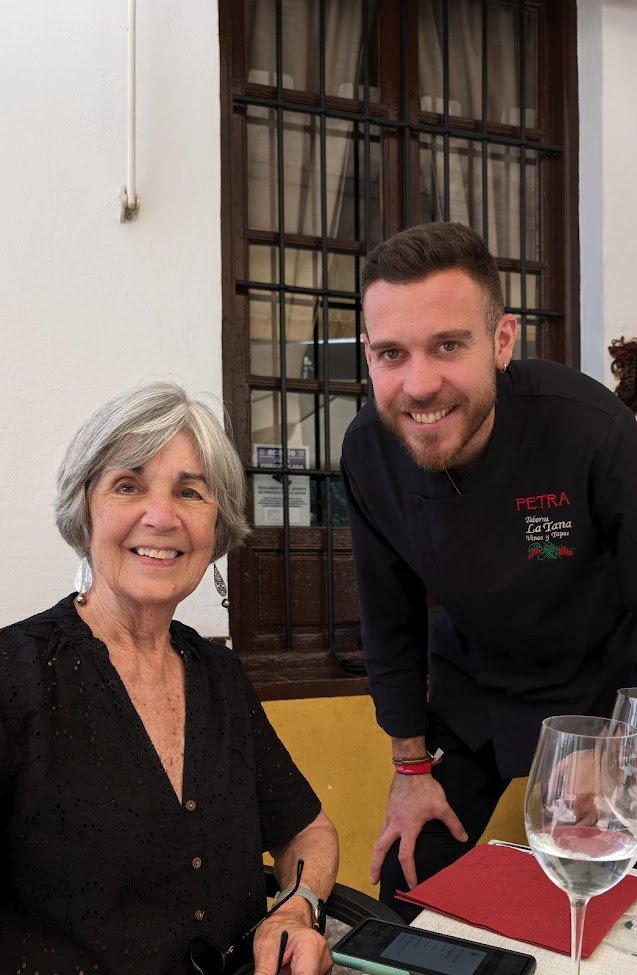
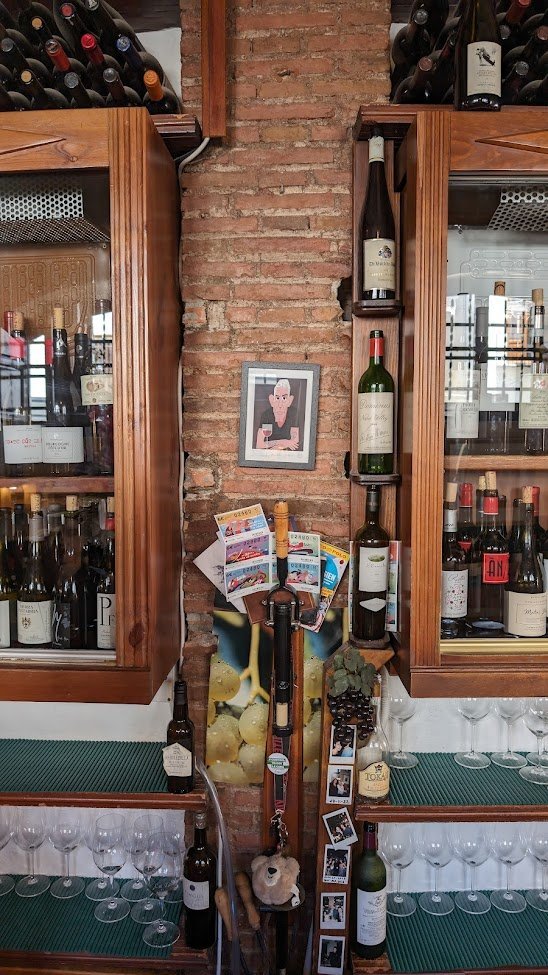
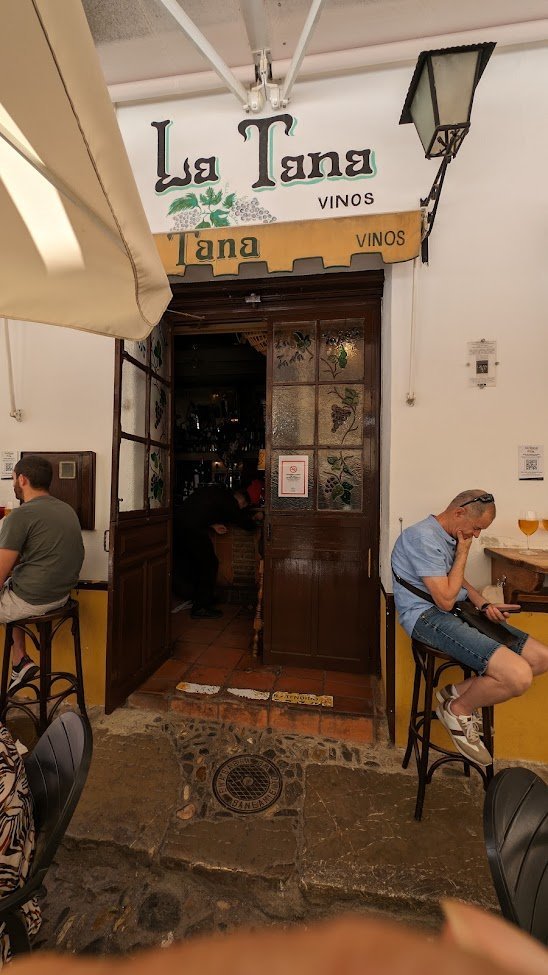
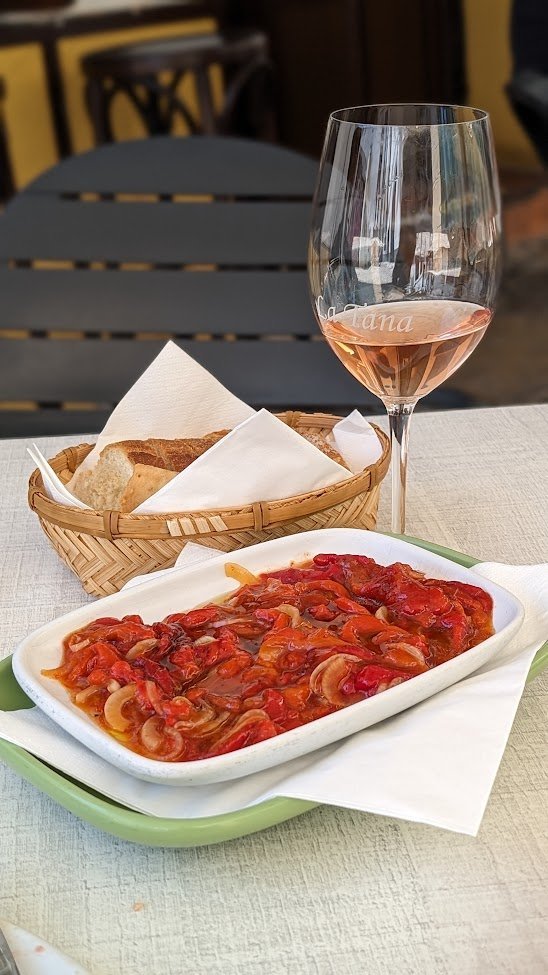
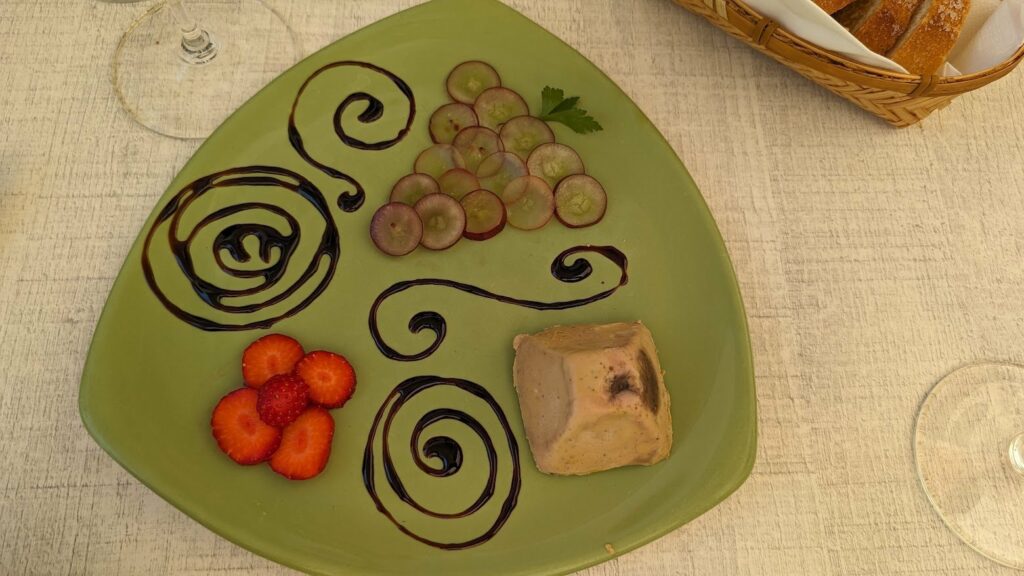
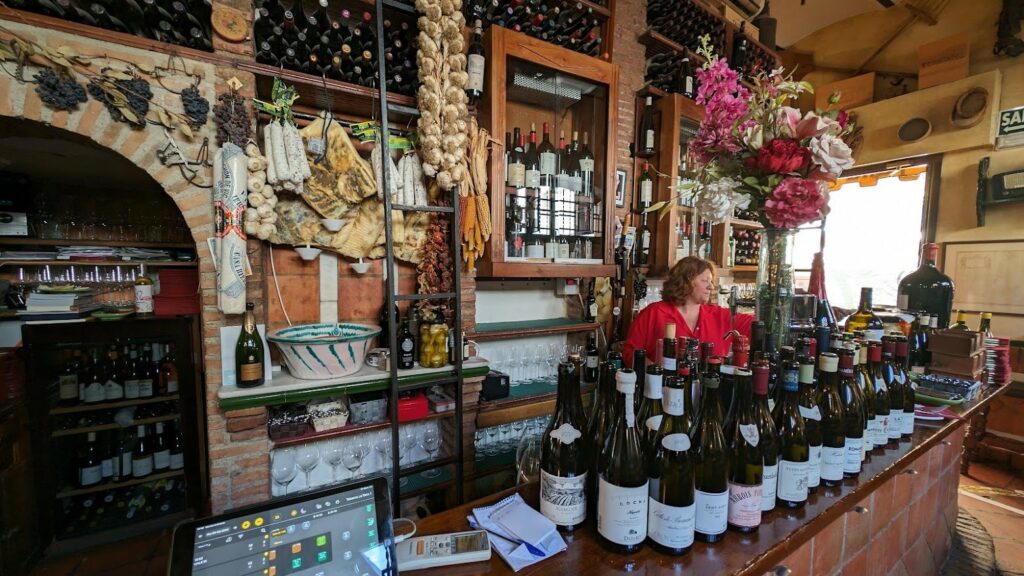
While the tapas we sampled here were delicious, the bar’s hallmark is its extensive wine selection from a cellar with over 10,000 bottles. If you’re looking for hot tapas, you’re out of luck here. But La Tana does serve a classic selection of cold dishes – some of the best we’ve savored in Spain.
Our free tapas featured a simply delicious combination of tomato, sausage, and bread, similar to what Bourdain enjoyed. We followed that with an order of sweet pimientos asados – red peppers roasted until tender and slightly charred then mixed with olive oil and sweet onion. I didn’t think we could put a dent in the large serving, but it was devoured before our next dish appeared.
As good as the peppers were, the best was yet to come, starting with “Media tenera machada.” This delicious dish, new to us, featured thin slices of slow-cooked pork shoulder served like carpaccio sprinkled with salt, olive oil, and hard-boiled quail egg. Ron’s favorite was last served – an artfully plated silky foie pate. Sliced grapes stacked like a cluster and a strawberry “flower” sat amid swirls of balsamic syrup. Both dishes paired well with the crisp white wines our friendly server suggested.
𝐑𝐞𝐬𝐭𝐚𝐮𝐫𝐚𝐧𝐭𝐞 𝐁𝐚𝐫 𝐎𝐥𝐢𝐯𝐞𝐫
We had walked by Restaurante Bar Oliver several times without knowing it was one of Bourdain’s tapas destinations. It is one of many eateries in the historic cathedral area, with a small dining room and bar and a shaded terrace for outdoor seating. Some are tourist traps, but we couldn’t help but notice that Bar Oliver was almost always packed with as many locals as visitors–a sure sign of an authentic dining experience.
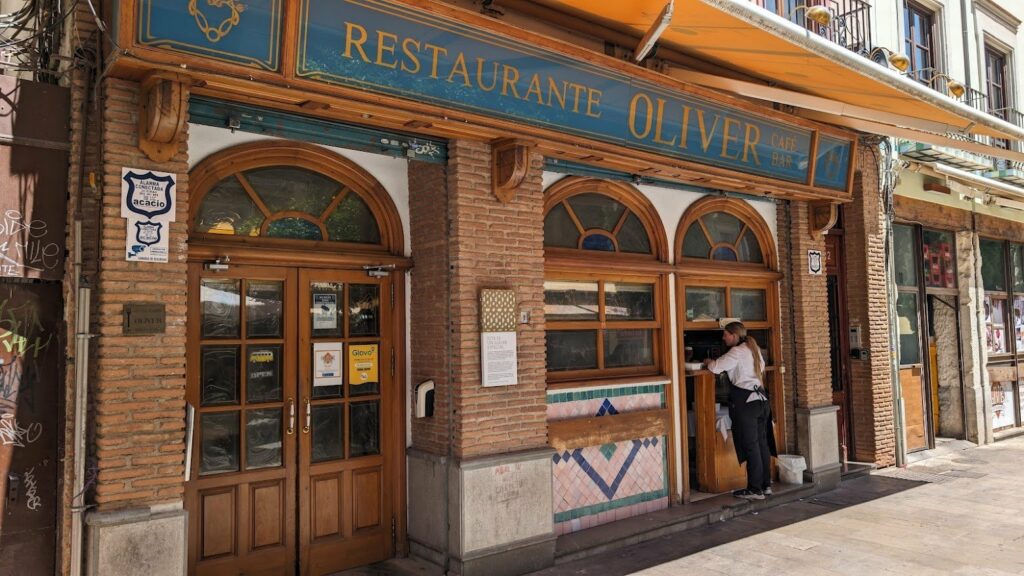
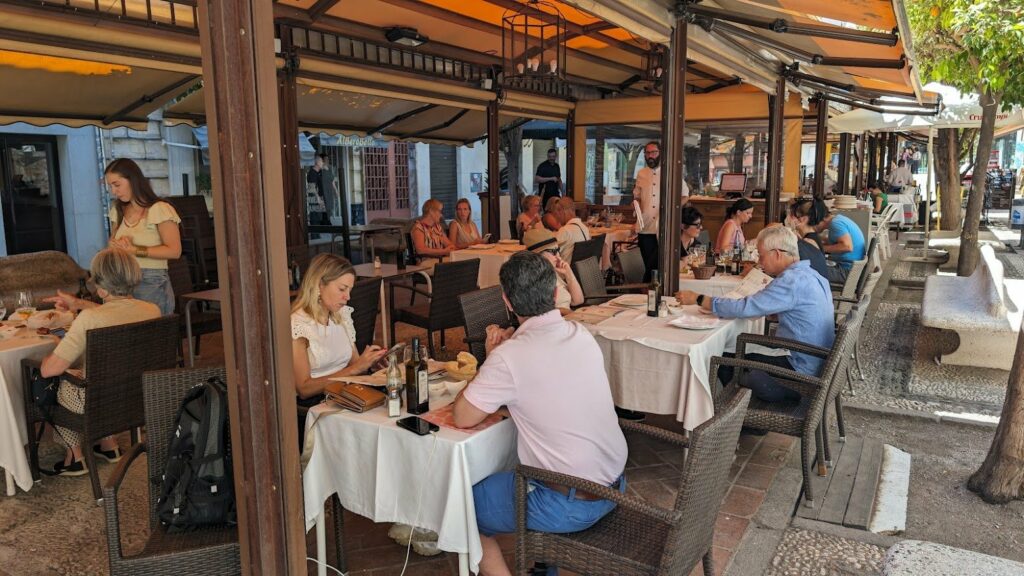
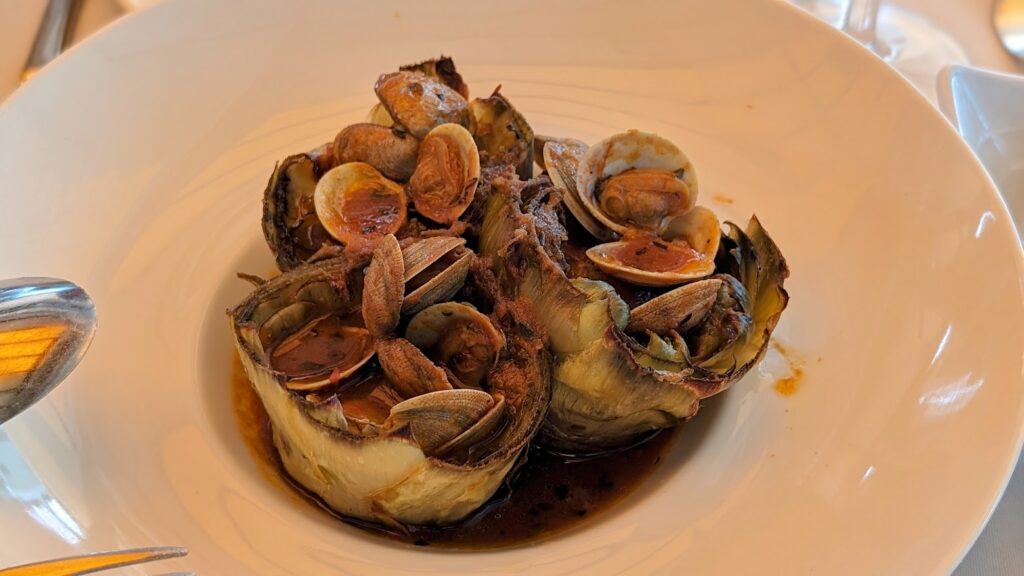
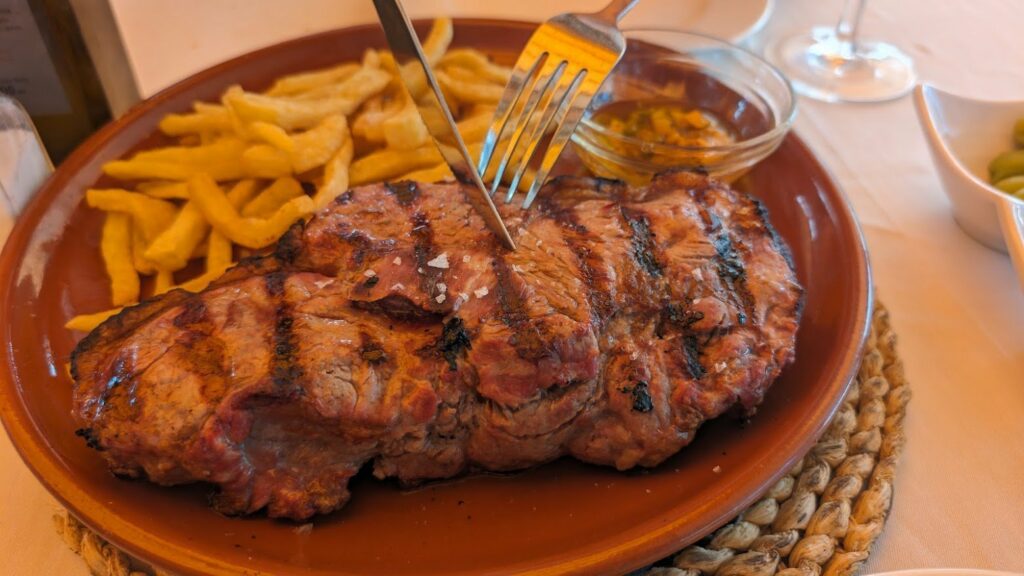
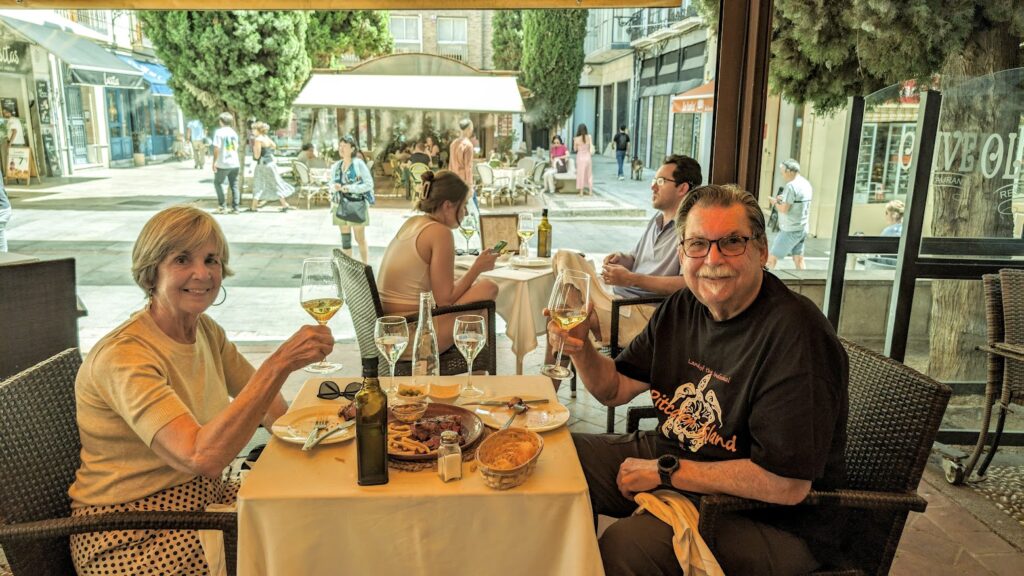
The century-old family restaurant is known for classic tapas, plus Andalusian rice, seafood, and meat dishes. We ordered a couple of glasses of fruity Verdejo white wine that arrived with a dish of green olives, an always welcome tapas but not comparable to the bowl of steamed clams Bourdain savored with his wine.
Our delightful server, Belem Oliver, we discovered, was the daughter of the owner, José Enrique Oliver. She runs the restaurant by day and her father takes over at night. When we mentioned Bourdain, she noted that they get customers from around the world following in his footsteps. She didn’t meet him but said her father had his picture taken with the great chef during his Granada tapas crawl.
Bourdain’s tapa put us in the mood for clams, so we ordered the artichoke hearts and clams – a satisfying starter that we followed with grilled veal. It was surprisingly large–cooked with a perfectly pink interior – and mostly tender and juicy. We took half of it home and turned it into tacos, satisfying another craving that always arises on these lengthy trips.
𝐁𝐚𝐫 𝐆𝐚𝐥𝐥𝐚𝐫𝐝𝐨
You have to work to find Bar Gallardo on Calle Pintor Rodríguez Acosta. Not exactly in a high-traffic tourist zone, it proved about a fifteen-minute hike from our apartment on a hot day, but well worth the effort.
It’s another multi-generational business where the owner proudly carries on a tradition of friendly hospitality and good food from fresh ingredients. Next to the bar, a large glass display case showcases today’s seafood and meats to customers curious about the daily menu.
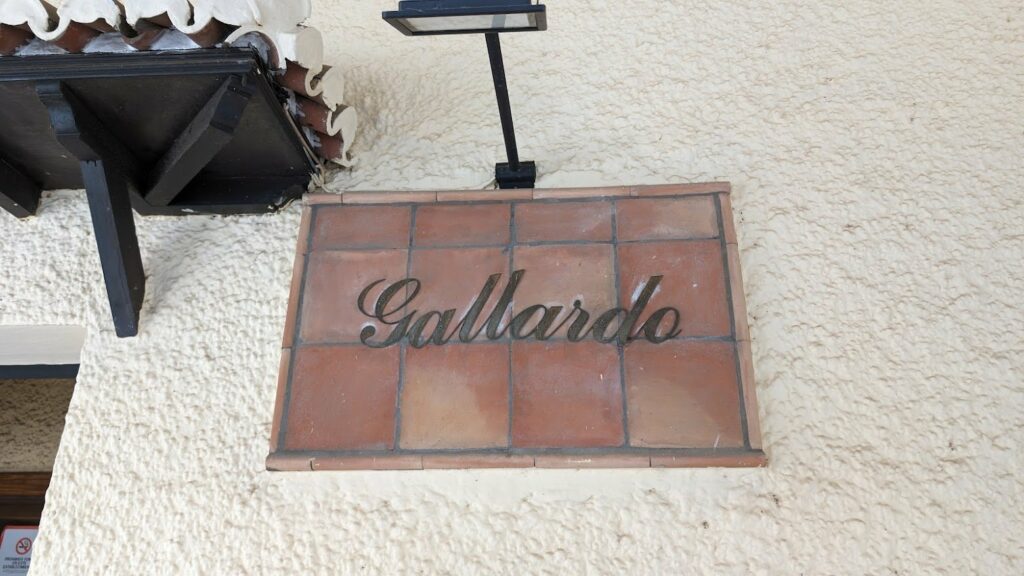
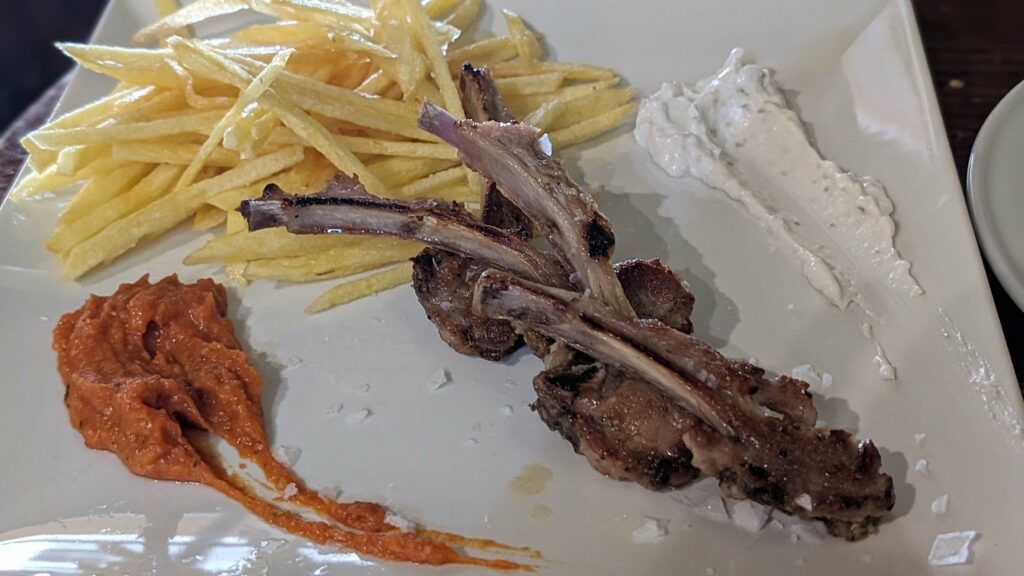
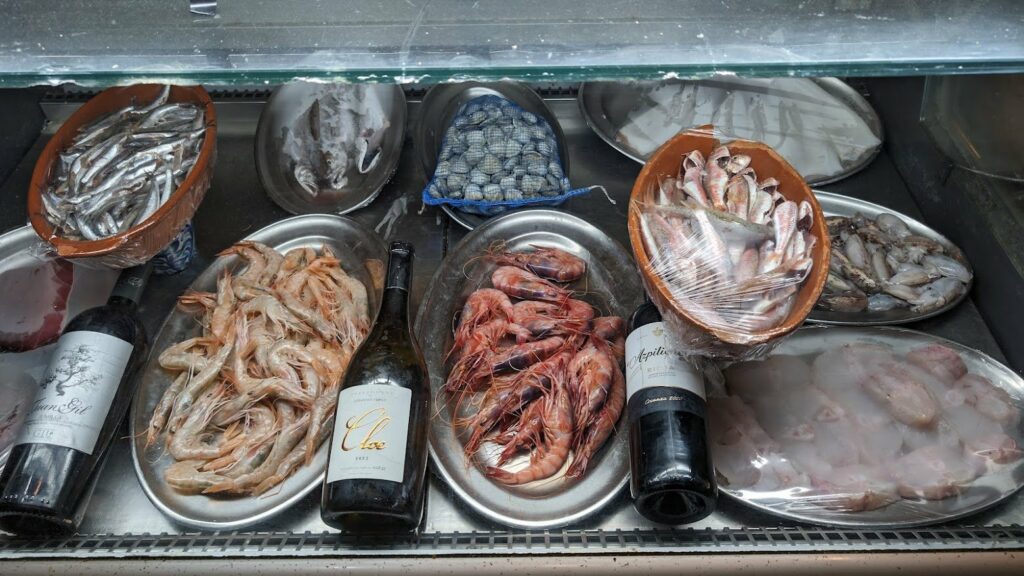
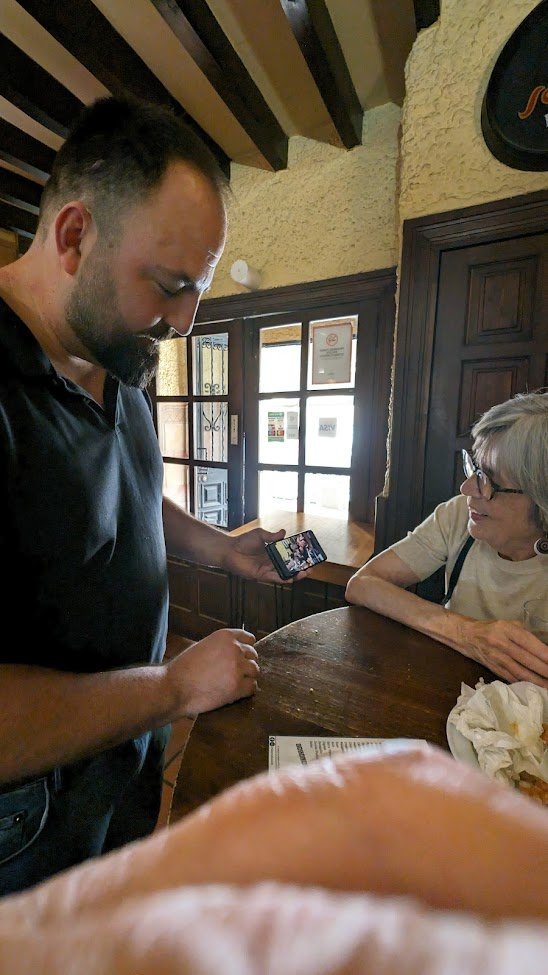
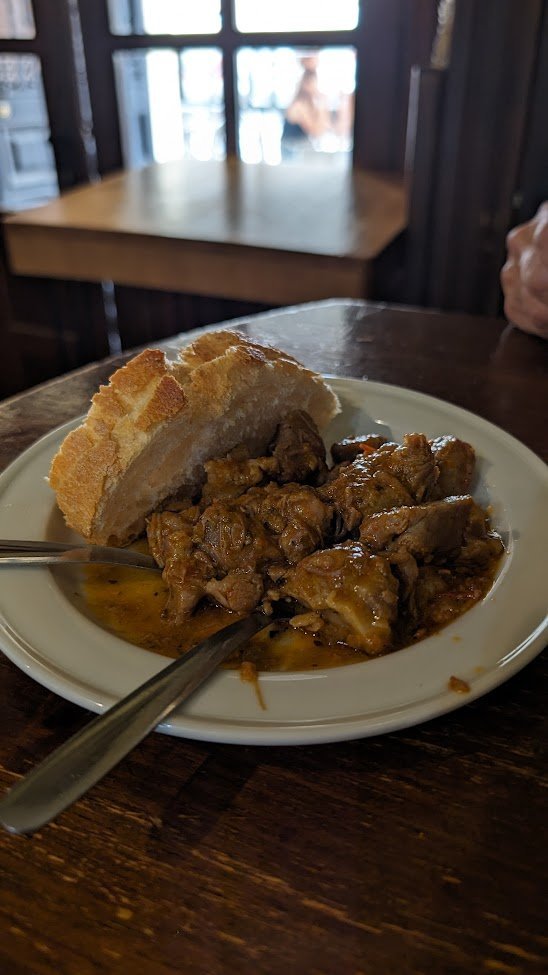
The modest but comfortable bar was Bourdain’s final tapas stop in Granada. By this time, he and his pals had consumed many tapas, each with a glass of something. Bourdain was feeling no pain.
“𝑨𝒔 𝒕𝒉𝒊𝒔 𝒅𝒆𝒂𝒕𝒉 𝒎𝒂𝒓𝒄𝒉 𝒐𝒇 𝒕𝒂𝒑𝒂𝒔 𝒄𝒐𝒏𝒕𝒊𝒏𝒖𝒆𝒔, 𝒕𝒉𝒊𝒏𝒈𝒔 𝒈𝒆𝒕 𝒂 𝒍𝒊𝒕𝒕𝒍𝒆 𝒘𝒆𝒊𝒓𝒅,” 𝑩𝒐𝒖𝒓𝒅𝒂𝒊𝒏 𝒎𝒖𝒎𝒃𝒍𝒆𝒅 𝒕𝒐 𝒉𝒊𝒔 𝒇𝒓𝒊𝒆𝒏𝒅. “𝑻𝒉𝒊𝒔 𝒊𝒔 𝒕𝒉𝒆 𝒔𝒕𝒐𝒓𝒚 𝒐𝒇 𝒎𝒚 𝒍𝒊𝒇𝒆. 𝑭𝒊𝒏𝒂𝒍𝒍𝒚, 𝑩𝒂𝒓 𝑮𝒂𝒍𝒍𝒂𝒓𝒅𝒐. 𝑱𝒖𝒔𝒕 𝒎𝒂𝒌𝒊𝒏𝒈 𝒊𝒕 𝒃𝒆𝒇𝒐𝒓𝒆 𝒄𝒍𝒐𝒔𝒊𝒏𝒈. 𝑵𝒐𝒘 𝒍𝒆𝒕’𝒔 𝒃𝒆 𝒉𝒐𝒏𝒆𝒔𝒕, 𝒘𝒆’𝒗𝒆 𝒉𝒂𝒅 𝒂 𝒍𝒐𝒕 𝒕𝒐 𝒆𝒂𝒕 𝒂𝒏𝒅 𝒅𝒓𝒊𝒏𝒌 𝒂𝒕 𝒕𝒉𝒊𝒔 𝒑𝒐𝒊𝒏𝒕. 𝑺𝒐𝒎𝒆 𝒓𝒆𝒔𝒕𝒓𝒂𝒊𝒏𝒕 𝒏𝒆𝒆𝒅𝒔 𝒕𝒐 𝒃𝒆 𝒔𝒉𝒐𝒘𝒏.”
Restraint is not something we associate with Anthony Bourdain. The plan to have one drink and one tapa and call it a night failed. They ended up with three beers and an equal number of tapas – cheese, boccarones (fried smelts), and chulatitas (little lamb chops). Bourdain judged it perfectly fine. “… seems like exactly what you want at the end of a long night of beer, wine, and many, many rounds of tapas.”
Our friendly bartender poured us two cold beers as we settled on stools at a corner table. About 30 seconds later, he returned with a large plate of carne en salsa. This beef stew-like tapa was meal-sized! And it was hands down my favorite. I could have scarfed down another few servings of the tender chunks of beef and savory sauce. Bourdain didn’t get this tapa, but he would have loved it.
After an order of a shrimp-studded Russian salad, moved on to the same chulatitas or lamb chops that Bourdain and friends had. The tiny lamb lollipops offered little meat but were incredibly tasty. As we were feasting on them, a bearded man approached our table from the kitchen. “Anthony Bourdain ordered those lamb chops,” he announced. We found out he was José Gallardo, the owner of the bar that had been in his family for three generations. He pulled out his phone and scrolled until he found a video of the Granada episode of “Parts Unknown. “That’s me, behind the bar,” he said with a grin..
It was one of those simple but memorable experiences we encounter regularly in Spain. And it’s a big reason we’ve grown to love this country. Anthony Bourdain felt it too as he reflected on his time in Granada.
“𝑵𝒊𝒄𝒆. 𝑨𝒘𝒆𝒔𝒐𝒎𝒆. 𝑻𝒉𝒊𝒔 𝒊𝒔 𝒕𝒉𝒆 𝒅𝒓𝒆𝒂𝒎 𝒐𝒇 𝒂𝒍𝒍 𝒕𝒉𝒆 𝒘𝒐𝒓𝒍𝒅. 𝑻𝒉𝒆 𝒅𝒓𝒆𝒂𝒎 𝒊𝒔 𝒕𝒐 𝒍𝒊𝒗𝒆 𝒊𝒏 𝑮𝒓𝒂𝒏𝒂𝒅𝒂. …𝒘𝒐𝒓𝒌 𝒊𝒏 𝒕𝒉𝒆 𝒎𝒐𝒓𝒏𝒊𝒏𝒈, 𝒉𝒂𝒗𝒆 𝒂 𝒐𝒏𝒆-𝒉𝒐𝒖𝒓 (𝒔𝒊𝒆𝒔𝒕𝒂) 𝒊𝒏 𝒕𝒉𝒆 𝒂𝒇𝒕𝒆𝒓𝒏𝒐𝒐𝒏, 𝒂𝒕 𝒏𝒊𝒈𝒉𝒕 𝒈𝒐 𝒐𝒖𝒕 𝒂𝒏𝒅 𝒉𝒂𝒗𝒆 𝒕𝒉𝒂𝒕 𝒍𝒊𝒇𝒆. … 𝒕𝒐 𝒍𝒐𝒐𝒌 𝒐𝒖𝒕 𝒕𝒉𝒆 𝒘𝒊𝒏𝒅𝒐𝒘 𝒂𝒏𝒅 𝒕𝒐 𝒔𝒆𝒆 𝑺𝒑𝒂𝒊𝒏.”
